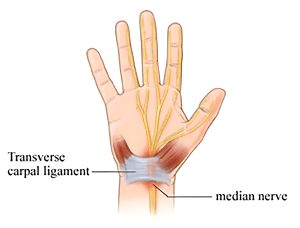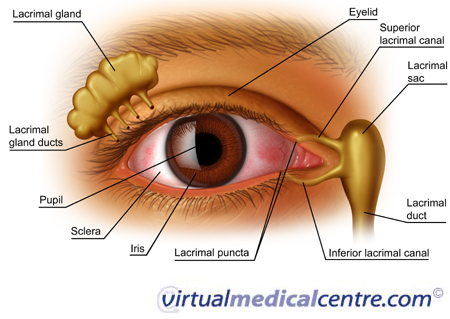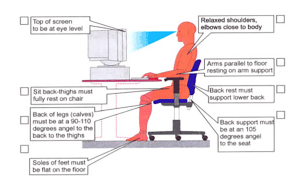Computer Induced Medical Problems & How to Avoid Them

Computer Induced Medical Problems & How to Avoid Them
It’s now common knowledge that posture and ergonomics are a very important part of avoiding RSI and other computer-use related injuries but after a chance search I found out there is a lot more we need to be wary of.
Here’s an exert straight from Wikipedia on a few other nasties:
Computer vision syndrome
In many cases, frequent computer users suffer from computer vision syndrome, which is a degenerative eye problem which can result in severely reduced eyesight (Myopia), blurred vision, overall eye tiredness and even Glaucoma. Computer Eye Syndrome is an umbrella term for many problems but the causes of these problems can be easily identified. When using a computer due to the size and setup of the monitor and components it is necessary for the user to be within at least two feet of the monitor when performing any type of computational work. This presents many problems especially in older monitors due to an elevated amount of monitor glare, poor display quality and insufficient picture display refresh rates. Although these problems are more evident in older computers the newer models are not free from these problems either. Studies have been conducted [6] into the correlation between computers and eye problems and it was found that the Ionizing radiation given off by monitors has severe detrimental effects on the eye and eyesight on a whole. They also state “Treatment requires a multidirectional approach combining ocular therapy with adjustment of the workstation”[6] which shows these problems are quite easily solved with minimal investment from computer manufacturers through producing higher quality monitors with better resolution and refresh rates. The most common form of Computer Vision Syndrome is a condition termed Dry Eye, which results in itchy, sore and even the illusion that something is stuck in your eye. This condition is often caused by extensively long period looking at a computer screen.
Video screens have a design process for user interface. Video screens can cause eyestrain from prolonged viewing. Cathode ray tubes are what are used to display the information on your computer. These send off radiation. This is a concern that has been taken into account when designing better computer screens for user interface.[4][5]
Musculoskeletal problems
Another medical issue caused by the use of computers is back and posture problems. These problems relate to musculoskeletal disorders caused by the need for the user to be crouched and hunched towards the monitors and computer components due to the design and positioning of these particular computer peripherals. This hunching forward of the user causes posture and back problems but is also the cause of severe and acute pain in the upper back, particularly pain in the neck and or shoulders. A study [7] was conducted where 2146 technical assistants installed a computer program to monitor the musculoskeletal pain they suffered and answered questionnaires on the location and severity of the pain. The study showed interesting results, as it detailed how in the majority of cases any pain suffered was aggravated and exacerbated by the use of computer peripherals like the mouse and keyboard but overall the pain did not originate from using computers. “Moreover, there seems to be no relationship between computer use and prolonged and chronic neck and shoulder pain”[7] This is a positive study for computer manufacturers but although the pain may not originate from computer peripherals there is no doubt that the pain is exacerbated by their use and this revelation alone should lead computer manufacturers to pioneer new technologies that reduce the risk of posture or musculoskeletal problems aggravated by the use of poorly designed and linearly designed computer peripherals.
In another study,[8] It was found that women are at a greater risk than men to suffer from musculoskeletal problems then men. Two explanations given were that “women appear to consistently report more neck and upper extremity symptoms than men.”, and that women may assume more taxing positions while working than men do due to differences in anthropometrics.
(Read the whole article HERE)
And from the Better Health Channel website comes more:
Posture-related injuries from computer use
Back and neck pain, headaches, and shoulder and arm pain are common computer-related injuries. Such muscle and joint problems can be caused or made worse by poor workstation (desk) design, bad posture and sitting for long periods of time.
Although sitting requires less muscular effort than standing, it still causes physical fatigue (tiredness) and you need to hold parts of your body steady for long periods of time. This reduces circulation of blood to your muscles, bones, tendons and ligaments, sometimes leading to stiffness and pain. If a workstation is not set up properly, these steady positions can put even greater stress on your muscles and joints.
Preventing computer-related muscle and joint injuries
Tips to avoid muscle and joint problems include:
- Sit at an adjustable desk specially designed for use with computers.
- Have the computer monitor (screen) either at eye level or slightly lower.
- Have your keyboard at a height that lets your elbows rest comfortably at your sides. Your forearms should be roughly parallel with the floor and level with the keyboard.
- Adjust your chair so that your feet rest flat on the floor, or use a footstool.
- Use an ergonomic chair, specially designed to help your spine hold its natural curve while sitting.
- Use an ergonomic keyboard so that your hands and wrists are in a more natural position.
- Take frequent short breaks and go for a walk, or do stretching exercises at your desk. Stand often.
Computer-related overuse injuries of the hand or arm
Muscles and tendons can become painful with repetitive movements and awkward postures. This is known as ‘overuse injury’ and typically occurs in the elbow, wrist or hand of computer users. Symptoms of these overuse injuries include pain, swelling, stiffness of the joints, weakness and numbness.

Preventing computer-related overuse injuries
Tips to avoid overuse injuries of the hand or arm include:
- Have your mouse at the same height as your correctly positioned keyboard.
- Position the mouse as close as possible to the side of the keyboard.
- Use your whole arm, not just your wrist, when using the mouse.
- Type lightly and gently.
- Mix your tasks to avoid long, uninterrupted stretches of using the computer.
- Remove your hands from the keyboard when not actively typing, to let your arms relax.
Eyestrain from computer use
Focusing your eyes at the same distance point for long periods of time causes fatigue. The human eye structurally prefers to look at objects more than six metres away, so any work performed close up puts extra demands on your eye muscles.
The illuminated computer screen can also cause eye fatigue. Although there is no evidence that eye fatigue damages your eyesight, computer users may get symptoms such as blurred vision, temporary inability to focus on faraway objects and headaches.

Preventing eyestrain from computer use
Tips to avoid eyestrain include:
- Make sure your main source of light (such as a window) is not shining into your face or directly onto the computer screen.
- Tilt the screen slightly to avoid reflections or glare.
- Make sure the screen is not too close to your face.
- Put the screen either at eye level or slightly lower.
- Reduce the contrast and brightness of your screen by adjusting the controls.
- Frequently look away from the screen and focus on faraway objects.
- Have regular eye examinations to check that any blurring, headaches and other associated problems are not caused by any underlying disorders.
Injuries from laptop computers
The growing use of laptop computers has caused more pains, strains and injuries among computer users.
Laptop computers were designed to be used for short periods of time when a person couldn’t access a desktop computer. But these days many people use a laptop all the time.
The problem is that the monitor and keyboard of a laptop are very close together. To position the monitor at the right height for your back and neck causes you to lift your arms and shoulders too high. But to position the keyboard at the best height for your arms and shoulders, you must hunch your shoulders and neck to see the monitor.
Carrying your laptop around can also strain your muscles and joints.
Preventing injury from laptop computers
Tips to reduce laptop dangers include:
- Use a correctly set-up desktop computer instead of a laptop as often as you can.
- Use peripheral equipment, such as a docking station, separate keyboard, mouse and laptop stand.
- Take frequent breaks.
- Carry your laptop in a backpack or in wheel-along luggage.
Children and computer-related injuries
Researchers believe that electronic games may be among the causes of childhood obesity (being very overweight). And like adults, children might also get overuse injuries of the hand, and muscle and joint problems such as back and neck pain or headaches.
Some research has shown that playing violent computer games and a large amount of game time may cause aggressive behaviour in some children and may negatively affect a child’s school work. Although computer and video games are fun and offer benefits such as improved spatial awareness, parents should keep in mind that moderation is important in avoiding health problems.
Health risks from computer games
Playing computer games for too long or without correct furniture and posture can lead to health problems such as:
- Overuse injuries of the hand
- Obesity
- Muscle and joint problems
- Eyestrain
- Behavioural problems including aggressive behaviour
- Photosensitive epileptic seizures (caused by flashing or rapidly changing lights – this is rare).
Parents can reduce the risk of children developing computer-related health problems. You can encourage your child to:
Sit at least one metre away from the screen
Take frequent breaks
Pursue other activities. Encourage your child to enjoy different hobbies and interests, particularly sports and physical activities.
You can also:
- Set sensible time limits on your child’s game playing. Some guidelines recommend no more than two hours of screen time each day
- Set up the computer, desk, chair and keyboard to suit your child’s height. For example, adjust the chair so that your child’s feet rest flat on the floor
- Buy an ergonomic chair
- Buy a smaller mouse, which suits the size of your child’s hand
- Teach your child to use the keyboard and mouse properly and safely, such as pushing the buttons and other controls gently. Using unnecessary force increases the risk of overuse injury.
Benefits of computer games
- Playing video and computer games is a lot of fun, and can offer children other important benefits too. Depending on the game, playing can improve:
- Spatial awareness
- Iconic skills (reading images or diagrams)
- Visual attention skills (such as keeping track of various objects at the same time)
- Attention span in children who have attention problems.
Where to get help
- Your doctor
- Physiotherapist
- Health and safety officer
- Australian Physiotherapy Association Tel. (03) 9092 0888 or 1300 306 622

Things to remember
- Working at a computer can cause back, neck and shoulder pains, headache, eyestrain and overuse injuries of the arms and hands.
- You can help avoid computer-related injuries with proper furniture, better posture and good working habits.
- Parents should put sensible time limits on their children’s computer use and video-game playing.
- Your child should take regular breaks from using a computer and should do some physical activities each day.

#02 65 841 551 :: sales@pcpitstop.com.au :: www.pcpitstop.com.au/blog
 |
 |
 |
 |
 |




